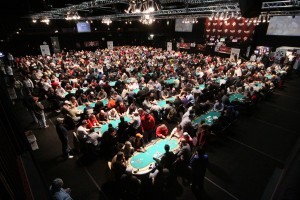Chip stack is an important weapon in poker, but how much does chip stack impact the likelihood of wining a poker game? There has been a ton written about this subject of poker. We might find some clues by analysing the chip stacks of the November 9 in 2014 to their wagering odds.
The table below shows each player in the 2014 November 9 with their % of the total chips left in play in one column, and another column showing their respective % chance as implied by their waging odds on Betfair. The betfair % odds were calculated using the backing (offer) price, so they add up to about 107%.
| Name | % Stack | % Betfair |
| Jorryt van Hoof | 19.14% | 20.00% |
| Felix Stephensen | 16.35% | 18.18% |
| Mark Newhouse | 12.97% | 14.29% |
| Andoni Larrabe | 11.25% | 14.29% |
| Dan Sindelar | 10.57% | 10.00% |
| Billy Pappas | 8.73% | 7.14% |
| William Tonking | 7.51% | 6.90% |
| Martin Jacobson | 7.43% | 11.11% |
| Bruno Politano | 6.05% | 5.88% |
Without doing any further statistical analysis, its clear the chance of each player winning is directly related to their chip stack. These numbers show the overwhelming factor that determines a player’s chances of winning a poker game is their relative chip stack. The correlation is also linear. If a player has twice as many chips, they are implied to be twice as likely to win.
What is also interesting about the November 9 in 2014 is the final table does not include any big name professional players. The wagering market is saying that without any additional bias of a player’s skill level, chip stack is the main criteria.
As November draws closer, it will be interesting to see if these odds change. Another lesson from this short analysis is buy in for the largest stack possible when playing poker, and re-buy as soon as possible (even when you don’t bust out). The larger your stack size, the better your chances of winning, plain and simple.





